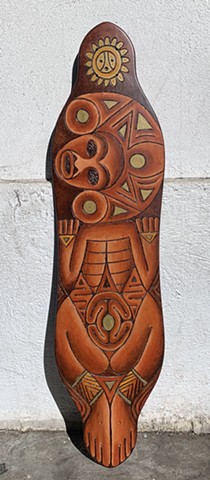Skateboard/Longboard Art
"This motif may represent a mythical tradition of an earlier period rooted in the ancient Amazonian mythical corpus, and whose meaning may be maybe lost in time and not recorded by Pane or any other explorer. Among the Guianas and the Orinoco valley, Magaña (1987:41, 43, 53, 79, 187) reported that there is a widespread mytheme [the essential component of a myth and a bridge between myths according to Lévi-Strauss (1955)] among the Wayana, Tareño and Kaliña Indians regarding an old mother-in-law that looses her head like the beheaded anthrozoomorphic figure (NW9). In other myths, the lost head becomes a constellation in the skies (Magaña (1987:87). In other similar myths compiled by Magaña (1987:245) among the Guianas Indians, the mother-in-law is substituted by an old step-frogmother. In this Kaliña myth, a woman gets pregnant from the sun and as a result a conflict arises among her brothers accusing each other of incest. They threatene to kill her, but the girl flees to the forest and meets an old-toad woman that gives her shelter. As the old woman is married to evil bird, the frog woman hid the girl into a kasili jar (cassava fermented drink). After several months, the girl gives birth to twins. The old frog woman no longer can hide the girl that is then devoured by the evil bird. However, old frog woman manages to save the twins. When they grew up, the old frog woman told them that her mother was eaten by a nocturnal bird, but she does not reveal the bird's identity. The twins went in search of the murderer bird and during their quest, they find a bird who fears for his life. This bird tells the real murderer's identity. As a result, the twins killed Evil Bird and Old Frog stepmother. In addition, there is another version of the same mytheme in which a pregnant woman gets lost in the forest despite the fact that the twins in her womb tell her where to go. She arrives to a jungle village where the Old Frog woman Kunawaru hid her from the Jaguar. However, the Jaguar found the woman and eats her. One day, the twins discovered the truth about their past and killed the Jaguar and Old Frog stepmother Kunawaru. The ancestors of the Tainos known as Saladoid originated in the Orinoco-Guiana region of South America, arriving in Puerto Rico around 250 A.D according to Rouse (1992:30-31, 52). As a result, their myths are rooted in the South American tradition of the Guianas. Pane (in Gaylord, 1906:323) on Chapter IX of his account mentioned that: . . . there came four sons of a woman whose name was Itiba Tahuuaua, all from one womb and twins; and this woman having died in travail they opened her and drew out these four sons,. . . In this myth as metaphor, Itiba Tahuuaua, represents Mother Earth and the four twins the four quarters of the world. Just one of the four sons has a name: Caracaracol. As observed by Rodriguez (2011: 82), among the Taino people, there were different versions of the same mytheme like the one reported by Pane (in Gaylord, 1906:324) in Chapter XI about opening the back of a culture hero (Caracaracol) with an ax and a living turtle came out from the wound. A variant of this mytheme is represented on the pictographs in Sanabe Cave, Dominican Republic. In one pictograph, Caracaracol is represented as a turtle-man, however one of his brothers is portrayed as Cobo man (rounded shoulder and a somewhat low conical form shell from the species, Citarrium pica). This detail was never reported in Pane's account. The ethnological evidence mentioned above suggests that the rotated-beheaded frog woman at Jacana represents a myth similar to that reported by Magaña (1987:245) from Guiana in which Caracaracol beheaded his old-toad steptmother. In addition, we propose here that at Jacana the head of old-frog stepmother (Figure 6) becomes the constellation of the Southern Cross. However, this remains an interpretation subject to further investigation." From: Jacana: Astronomy of a Prehistoric Site on Southwestern Puerto Rico, Angel Rodriguez Ph.D
